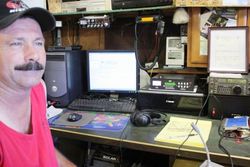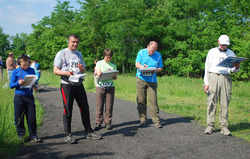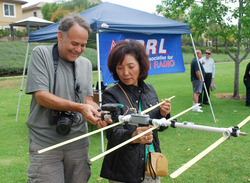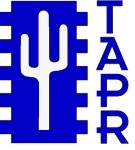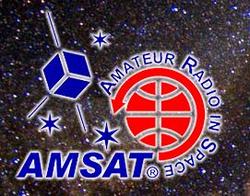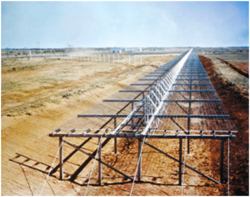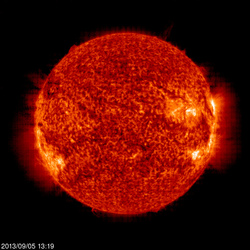 September 5, 2013 John E. Ross, KD8IDJ, Editor
| ||||||||||||
Public Service: ARES-RACES Volunteers Conclude Rim Fire Activation Amateur Radio volunteers supporting the Red Cross and local government in the wake of the gigantic Rim Fire, in and near California's Yosemite National Park and the Stanislaus National Forest, have stood down after 16 days on duty. The initial callout on August 19 responded to a request to assist the Red Cross in setting up an evacuation center in Groveland, California. Shelter operations relocated the following day to the Tuolumne County Fairgrounds in
Sonora, Tuolumne County ARES Emergency Coordinator Carl Croci, NI6Z, reported. Also on August 20, the Tuolumne County Office of Emergency Services requested Amateur Radio assistance to staff the Sonora Red Cross shelter and the community information telephone system at the Tuolumne County emergency operations center. Croci and Tuolumne County RACES Radio Officer Phil Fish, WB6GGY, handled the callout and soon had volunteers for both locations as well as some on standby. On September 4, Croci announced the end of the ARES-RACES activation. "This morning, I learned the Rim Fire was considered 80 percent contained," he said. "The community information phones have been secured. All evacuations have been lifted, the Red Cross is dismantling the shelter, and we ham radio operators are trying to get our stations back in working order." At one point the Tuolumne County Fairgrounds was sheltering some 100 evacuees. Croci said that in the Groveland area, where he lives, residents are still dealing with morning smoke, which he anticipates will remain for a while. "Estimates are the fire will not be considered out until the first rain or snow," he added.
More than two dozen radio amateurs were involved in the Rim Fire callout. Croci said the US Forest Service Type One Team told him that the combined operation conducted by Tuolumne County OES, ARES-RACES, the Tuolumne chapter of the Red Cross and the cooperation of the people of Tuolumne County will serve as an example for future operations." Croci expressed his thanks to all volunteers, and cited Fish "for his extraordinary operation and scheduling of personnel during the Rim Fire and Barbara Fish, KE6RGP, for leading the PIO operation." Volunteers from Calaveras County ARES also participated in the activation.
To the south, Fresno County ARES assisted the Central Valley Red Cross with communications, relaying information from a shelter to the Red Cross headquarters in Fresno. For a time Mariposa County ARES staffed a shelter at Greeley Hills Community Center, ready to pass traffic to Red Cross Headquarters. ARRL San Joaquin Valley Section Manager Dan Pruitt, AE6SX, said volunteers set up August 26 at the Red Cross office in Fresno, where they installed a station capable of operating on emergency power. "We made contact with Mariposa County ARES at the Greeley Hill shelter," Pruitt said. "We passed traffic until we were asked to shut down for the night." Volunteers returned early the next day. They dismantled the station on August 27. Pruitt said eight volunteers turned out for that activation. During the activation, Fresno County ARES used Fldigi and Flmsg -- a forms management editor -- on PSK125 to pass traffic from the shelter and the Red Cross Headquarters. "We found that the faster speed and wider signal [resulted in] fewer errors." Pruitt said, adding that the Red Cross "was very impressed" with their ability to send and receive traffic in the Incident Command System general message form (ICS-213), filled out and printed. As of September 4, the Rim Fire had claimed nearly 236,000 acres and more than 100 structures, including a few homes. The cost to date of battling the fire was estimated at more than $77 million. North Carolina to Host 2013 US Direction Finding Competition The Uwharrie Mountains of North Carolina will provide the locale for the 13th USA Amateur Radio Direction Finding (ARDF) Championships of on-foot hidden transmitter hunting. Fans of this international sport, also known as "foxtailing" or "radio-orienteering,"
are making travels plans now. Backwoods Orienteering Klub (BOK) will host the event, which will be held October 8-13. This year's USA Championships are being combined with the Seventh ARDF Championships of International Amateur Radio Union (IARU) Region 2 (the Americas). On October 9 are optional practice sessions on 2 meters and 80 meters. October 10 brings model events of two activities introduced last year -- sprints and foxoring -- followed that afternoon by the championship foxoring event. The sprint championship event takes place on October 11. Classic transmitter hunting championship competition is held Saturday and Sunday, October 12 and 13. Transmitters will be on 2 meters and 80 meters the afternoon of October 11 for last-minute practice and equipment testing, with a procedures and safety briefing afterward.
Saturday morning will be the full-course 2 meter main event, followed in the evening by the banquet and awards presentation. The full-course 80 meter main event takes place Sunday morning, with awards presented afterwards. In the classic ARDF championships, competitors start in small groups made up of different age/gender categories. As they seek the hidden transmitters, they navigate through the forest from the starting corridor to the finish line -- a distance of 4 to 10 kilometers. They plot their direction-finding bearings on orienteering maps that show terrain features, elevation contours, and vegetation type. The USA ARDF Championships are open to anyone who can safely navigate the woods. A ham radio license is not required. Each participant competes as an individual, and any teamwork or GPS use are forbidden. Competitors bring their own direction-finding gear to the events, although extra gear is sometimes available for loan from other attendees. Competitors may not transmit on the course, except in emergencies.
Registration is now open, and an online entry form, detailed schedules, frequencies, lodging information and registration forms are on the BOK website. Competitors can avoid late fees by signing up no later than September 15. An e-mail reflector is available for Q&A with the organizers as well as for coordinating transportation and arranging equipment loans. Basic information on international-style transmitter hunting is on the Homing In website, including rules and signal parameters. The site includes equipment ideas for 2 meters and 80 meters, plus photos from previous championships. Information about the Amateur Radio Direction Finding Fund are on the ARRL website. Read more. -- Joe Moell, KØOV, ARRL Amateur Radio Direction Finding Coordinator Events: EuroBasket 2013 Award Slovenia Offered To mark the occasion of the EuroBasket 2013 basketball competition 2013 in Slovenia September 4-22, ZRS, the Association of Radio Amateurs of Slovenia, is offering an award to all radio amateurs and
SWLs for contacting/monitoring S5 special event stations with three-digit prefix and EB suffixes (eg S513EB, S541EB) and stations from the 24 countries fielding EuroBasket teams, between August 1 and September 22, 2013. All bands and modes may be used, but cross-mode, cross-band, repeater or VoIP contacts are invalid. Count each special S5 station once, regardless of the band/mode used. European stations qualify by working stations from at least 18 qualifying countries plus five special S5 stations. Non-European stations qualify by working stations from at least 15 qualifying countries plus two special S5 stations. Countries participating in EuroBasket 2013 are 4L, 4O, 4X, 9A, DL, E7, EA, F, G, I, LY, OH, OK, ON, S5, SM, SP, SV, TA, UA, UR, YL, YU, and Z3. The award is free via electronic PDF download. Send your application with your call sign, full name, e-mail address, and contact details via e-mail to ZRS Award Manager Milos Oblak, S53EO. The application deadline is December 31, 2013. -- The Daily DX via Milos Oblak, S53EO Events: TAPR/ARRL Digital Communications Conference to Offer Wide-Ranging Forum Schedule
A preliminary schedule has been posted for the 32nd annual TAPR/ARRL Digital Communications Conference in Seattle later this month. Among the forum topics: "Raspberry Pi Applications in Digital Communications: A Mobile Xastir-Based APRS Station," "High Performance BPSK31: Ideas for a New Generation," "Narrowband IP over Amateur Radio Networks (NIPARnets): Next-Generation Networking for Amateur Radio," and "Noise Power Ratio (NPR) Testing of HF Receivers." This year's banquet speaker will be Tom Van Baak, on the topic "Passion and Precision: Adventures of a Time Nut." Van Baak is a retired operating systems software engineer with a serious amateur interest in precision timekeeping. Rob Frohne, KL7NA, will present the Sunday Seminar, "A Tutorial on Android Programming." The DCC takes place at the Cedarbrook Lodge in Seattle, Friday through Sunday, September 20-22. The early bird discount for advance registration has been extended to midnight Friday, September 13. The Cedarbrook Lodge is sold out for DCC Friday, but other hotels with rooms available are within walking distance. Attendees are invited to bring and show their demos in the DCC demo room, which will be open Friday and Saturday of the DCC. The TAPR Board of Directors will meet Thursday, September 19, 9 AM to 5 PM at The Cedarbrook Lodge (room TBA). Full information is on the TAPR website. Events: AMSAT Space Symposium 2013 Set for November
The 2013 AMSAT Space Symposium will take place in Houston, Texas, November 1-3 at the Marriott Hobby Airport Hotel. Hosted by the Johnson Space Center Amateur Radio Club, this year's Symposium will feature presentations on satellite construction and operation as well as on other space-related subjects. The AMSAT Annual Meeting, held in conjunction with the Space Symposium, provides AMSAT members an opportunity to learn about AMSAT's future plans and voice opinions to the AMSAT Board of Directors and AMSAT officials. A downloadable registration form now is available via the AMSAT website. Online registration is expected to be available in late August. For hotel reservations visit the Marriott Hobby Airport Hotel website or call 713-943-7979. Use the code AMSAMSA or ask for the AMSAT block. Technology: US "Space Fence" Shut Down The Air Force Space Surveillance System (AFSSS) -- the "Space Fence" -- used to detect objects in orbit, was turned off September 1. Three transmitter sites operate on 216.983, 216.97, and 216.99 MHz, and there are six receiving stations. Some Amateur Radio meteor scatter enthusiasts enjoyed monitoring the VHF transmissions for indications of activity.
Attributed to the automatic budget cuts known as "sequestration," the shutdown came a month earlier than anticipated. Early in August Space News reported that Gen William Shelton, commander of Air Force Space Command, had directed the AFSSS, located in Texas, "be closed and all sites vacated" effective October 1, the start of the new US government fiscal year. Air Force Space Command Public Affairs reported August 13, "AFSPC officials have devised modified operating modes for the Perimeter Acquisition Radar Characterization System at Cavalier Air Force Station, North Dakota, and for the space surveillance radar at Eglin Air Force Base, Florida, allowing discontinuation of AFSSS operations while still maintaining space situational awareness." A new Space Fence radar is planned for Kwajalein Island in the Marshall Islands. -- SatWatch; USAF Public Affairs People: New Air Force MARS Chief Takes Reins of Command David J. Stapchuk is the new chief of Air Force MARS. He assumed command August 23 from outgoing chief Richard S. Jenson, who has taken on a new assignment. Stapchuk is the director of operations at the 92nd Information Operations Squadron Detachment 1 at Scott Air Force Base in Illinois. In that role he oversees cyber operations in support of the detachment's communications security mission. "I am excited about my new role as chief, Air Force MARS, and look forward to advancing the Air Force MARS program in fulfillment of the MARS mission to provide contingency radio communications support to US government operations," Stapchuk said. Stapchuk spent 28 years on active duty as an electronics technician and is currently an information technology specialist. He has supported a variety of Air Force missions over the last 34 years. -- Air Force MARS news release People: Well-known DXer and DX Steve Hodgson, ZC4LI, SK A familiar DX and contesting call sign has gone quiet. Steve Hodgson, ZC4LI, of Cyprus died August 31 of cancer. He was 69. Hodgson also was on the air over the years as 5B4AHA, C4C, GØLII, G6G, and ZD8LII, and was active until a few weeks ago. Adrian, 5B4AIY, called him "an enthusiastic contest operator [who] had won many awards. I'm sure his call will be sorely missed." Mark, N2QT, said ZC4LI was a familiar call sign to any RTTY contester. Hodgson will be buried in the Military Cemetery in Cyprus. Digital QST Access Using Adobe AIR 3.8 Restored Adobe has restored access to downloaded issues of digital QST using the latest Adobe® AIR⢠ver 3.8 on Windows operating systems. To download the latest Adobe® AIR⢠version, visit the Adobe AIR web page. Getting It Right! In the article "Australia Ends Higher Power Trial for Radio Amateurs," which appeared in The ARRL Letter, August 29, 2013, we erroneously identified the New Zealand Association of Radio Transmitters (NZART). Solar Update
Sun watcher Tad Cook, K7RA, in Seattle, Washington, reports: Conditions were quieter again this week. Average daily sunspot numbers declined from 77 to 69, and average daily solar flux was off by 9.5 points to 106.9, when compared to the previous 7 days, August 22-28.
Predicted solar flux for the near term:
Predicted planetary A index:
The autumnal equinox (September 22 at 2044 UTC) is a little over two weeks away. Fall is always a great time for HF DX, when the sun casts an even face over the northern and southern hemispheres. If this is the peak for cycle 24, although solar activity is weak, this may be the best time for enjoying HF propagation for some years to come. In tomorrow's bulletin, we'll have some averages for the past month and three months, and perhaps some reports from readers. This Week in Radiosport
Upcoming ARRL Section, State and Division Conventions and Events
Find conventions and hamfests in your area. ARRL -- Your One-Stop Resource for Amateur Radio News and Information Join or Renew Today! ARRL membership includes QST, Amateur Radio's most popular and informative journal, delivered to your mailbox each month. Subscribe to... NCJ -- National Contest Journal. Published bi-monthly, features articles by top contesters, letters, hints, statistics, scores, NA Sprint and QSO Parties. QEX -- A Forum for Communications Experimenters. Published bi-monthly, features technical articles, construction projects, columns and other items of interest to radio amateurs and communications professionals. Free of charge to ARRL members: Subscribe to the ARES E-Letter (monthly public service and emergency communications news), the ARRL Contest Update (bi-weekly contest newsletter), Division and Section news alerts -- and much more! | ||||||||||||
.png)

